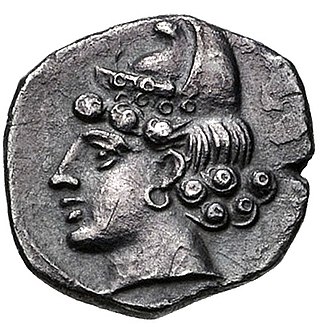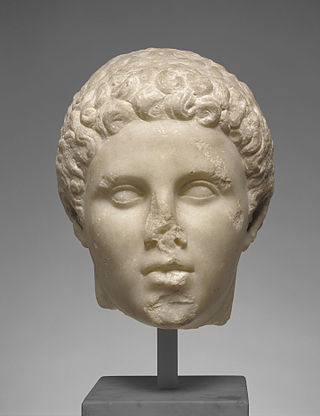
Alexander III of Macedon, commonly known as Alexander the Great, was a king of the ancient Greek kingdom of Macedon. He succeeded his father Philip II to the throne in 336 BC at the age of 20, and spent most of his ruling years conducting a lengthy military campaign throughout Western Asia and Egypt. By the age of 30, he had created one of the largest empires in history, stretching from Greece to northwestern India. He was undefeated in battle and is widely considered to be one of history's greatest and most successful military commanders.

Darius III was the last Achaemenid King of Kings of Persia, reigning from 336 BC to his death in 330 BC.
This article concerns the period 339 BC – 330 BC.
Bagoas was a prominent Persian official who served as the vizier of the Achaemenid Empire until his death.

Eileen Mary Challans, known by her pen name Mary Renault, was an English writer best known for her historical novels set in ancient Greece.

Arses, also known by his regnal name Artaxerxes IV, was the twelfth Achaemenid King of Kings from 338 to 336 BC.

Hephaestion, son of Amyntor, was an ancient Macedonian nobleman of probable "Attic or Ionian extraction" and a general in the army of Alexander the Great. He was "by far the dearest of all the king's friends; he had been brought up with Alexander and shared all his secrets." This relationship lasted throughout their lives, and was compared, by others as well as themselves, to that of Achilles and Patroclus.

The Battle of Gaugamela, also called the Battle of Arbela, took place in 331 BC between the forces of the Army of Macedon under Alexander the Great and the Persian Army under King Darius III. It was the second and final battle between the two kings, and is considered to be the final blow to the Achaemenid Empire, resulting in its complete conquest by Alexander.

Ochus, known by his dynastic name Artaxerxes III, was King of Kings of the Achaemenid Empire from 359/58 to 338 BC. He was the son and successor of Artaxerxes II and his mother was Stateira.

The wars of Alexander the Great were a series of conquests that were carried out by Alexander III of Macedon from 336 BC to 323 BC. They began with battles against the Achaemenid Persian Empire, then under the rule of Darius III of Persia. After Alexander's chain of victories against Achaemenid Persia, he began a campaign against local chieftains and warlords that stretched as far from Greece as the region of Punjab in South Asia. At the time of his death, he ruled over most regions of Greece and the conquered Achaemenid Empire ; he did not, however, manage to conquer the Indian subcontinent in its entirety according to his initial plan. Despite his military accomplishments, Alexander did not provide any stable alternative to the rule of the Achaemenid Empire, and his untimely death threw the vast territories he conquered into a series of civil wars, commonly known as the Wars of the Diadochi.

Thaïs or Thais was a famous Greek hetaira who accompanied Alexander the Great on his campaigns. Likely from Athens, she is most famous for instigating the burning of Persepolis. At the time, Thaïs was the lover of Ptolemy I Soter, one of Alexander's close companions and generals. It has been suggested that she may also have been Alexander's lover, on the basis of Athenaeus's statement that Alexander liked to "keep Thaïs with him", but this may simply mean he enjoyed her company, as she is said to have been very witty and entertaining. Athenaeus also says that after Alexander's death Ptolemy married Thaïs, who bore three of his children, and may also have become a Queen of Egypt.

Gedrosia is the Hellenized name of the part of coastal Balochistan that roughly corresponds to today's Makran. In books about Alexander the Great and his successors, the area referred to as Gedrosia runs from the Indus River to the north-eastern edge of the Strait of Hormuz. It is directly to the south of the countries of Bactria, Arachosia and Drangiana, to the east of the country of Carmania and due west of the Indus River which formed a natural boundary between it and Western India. The native name of Gedrosia might have been Gwadar as there are two towns by that name and a bay in central Makran.

The Nature of Alexander (1975) is a nonfiction work by novelist Mary Renault (1905–1983).

Bagoas was the name of two eunuchs in the court of the Persian Empire in the 4th century BC. Bagoas the Younger was a courtier of Darius III and later of Alexander the Great.

Fire from Heaven is a 1969 historical novel by Mary Renault about the childhood and youth of Alexander the Great. It reportedly was a major inspiration for the Oliver Stone film Alexander. The book was nominated for the “Lost Man Booker Prize” of 1970, "a contest delayed by 40 years because a reshuffling of the fledgeling competition’s rules", but lost out to Troubles by J. G. Farrell.

The Last of the Wine is Mary Renault's first novel set in ancient Greece, the setting that would become her most important arena. The novel was published in 1956 and is the second of her works to feature male homosexuality as a major theme. It was a bestseller within the gay community. The book is a portrait of Athens at the close of the Golden Age and the end of the Peloponnesian War with Sparta, and includes Socrates as a character.

Funeral Games is a 1981 historical novel by Mary Renault, dealing with the death of Alexander the Great and its aftermath, the gradual disintegration of his empire. It is the final book of her Alexander trilogy.

The historical and literary tradition describes several of Alexander's relations, some of which are the subject of question among modern historians.
Eunuchs have appeared in many films, works of literature, and in popular culture.
Orxines was a Persian noble, descended from Cyrus the Great.















